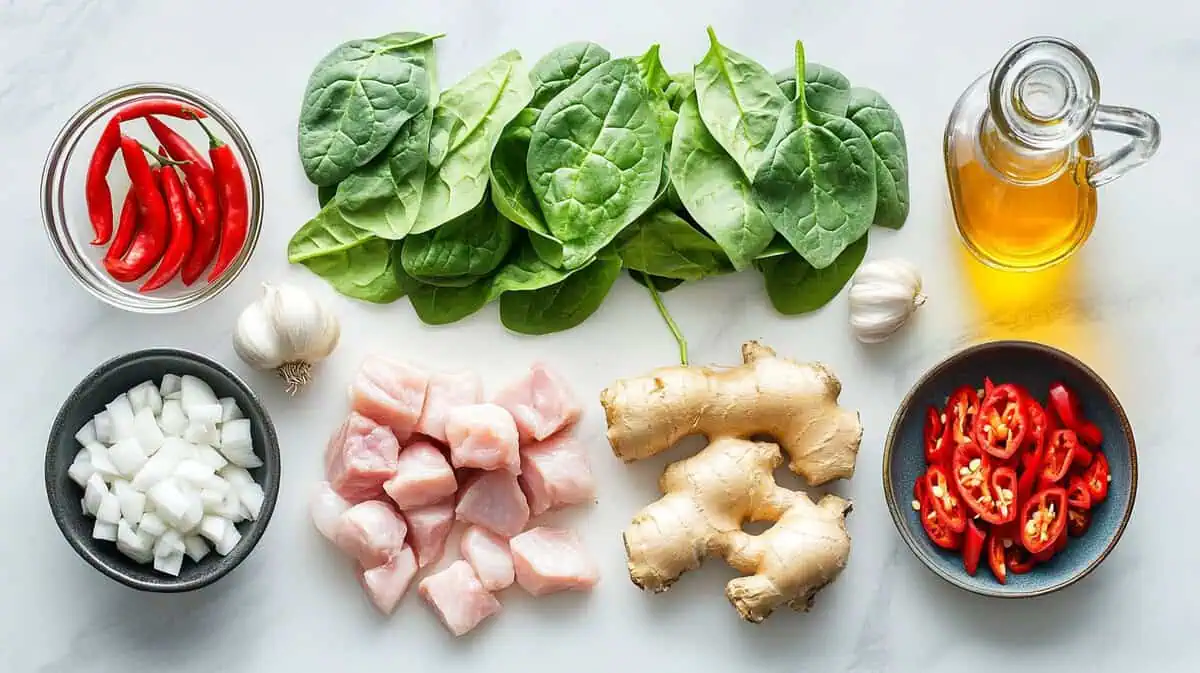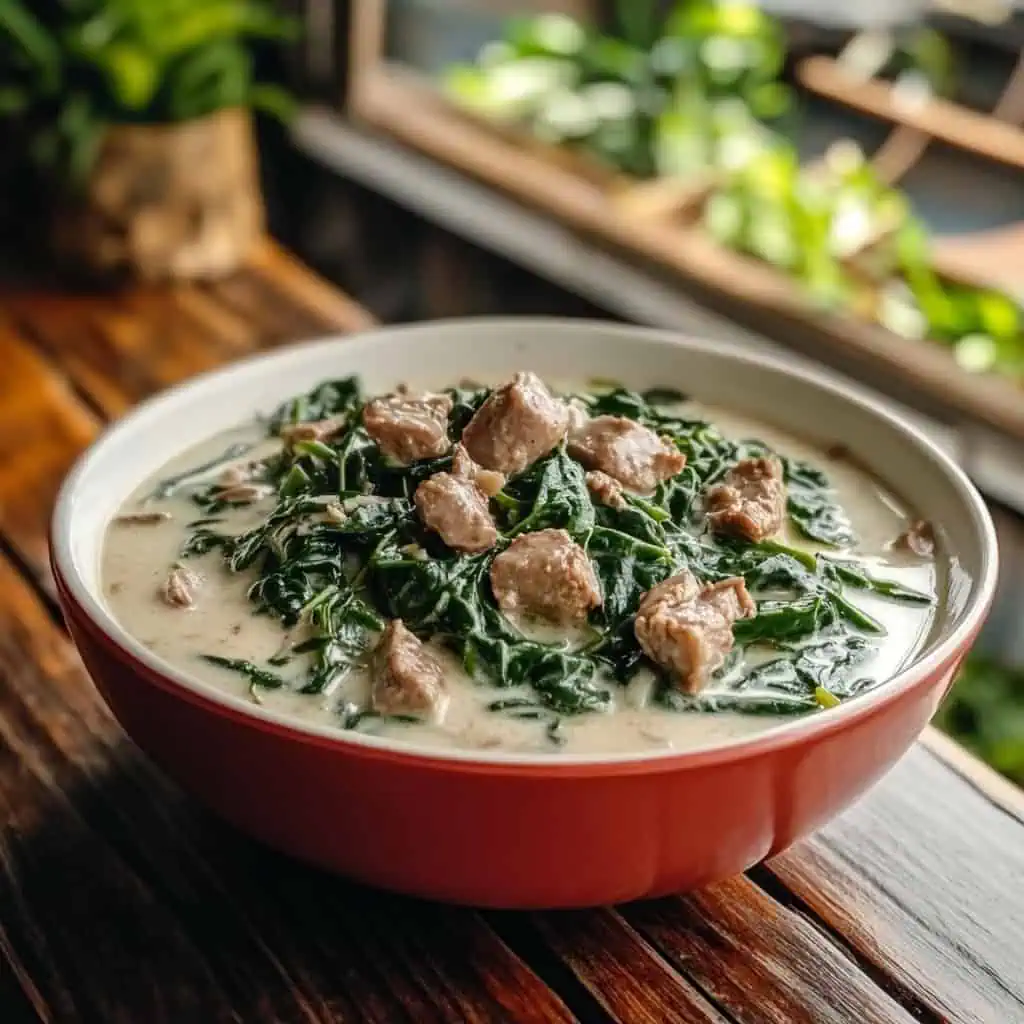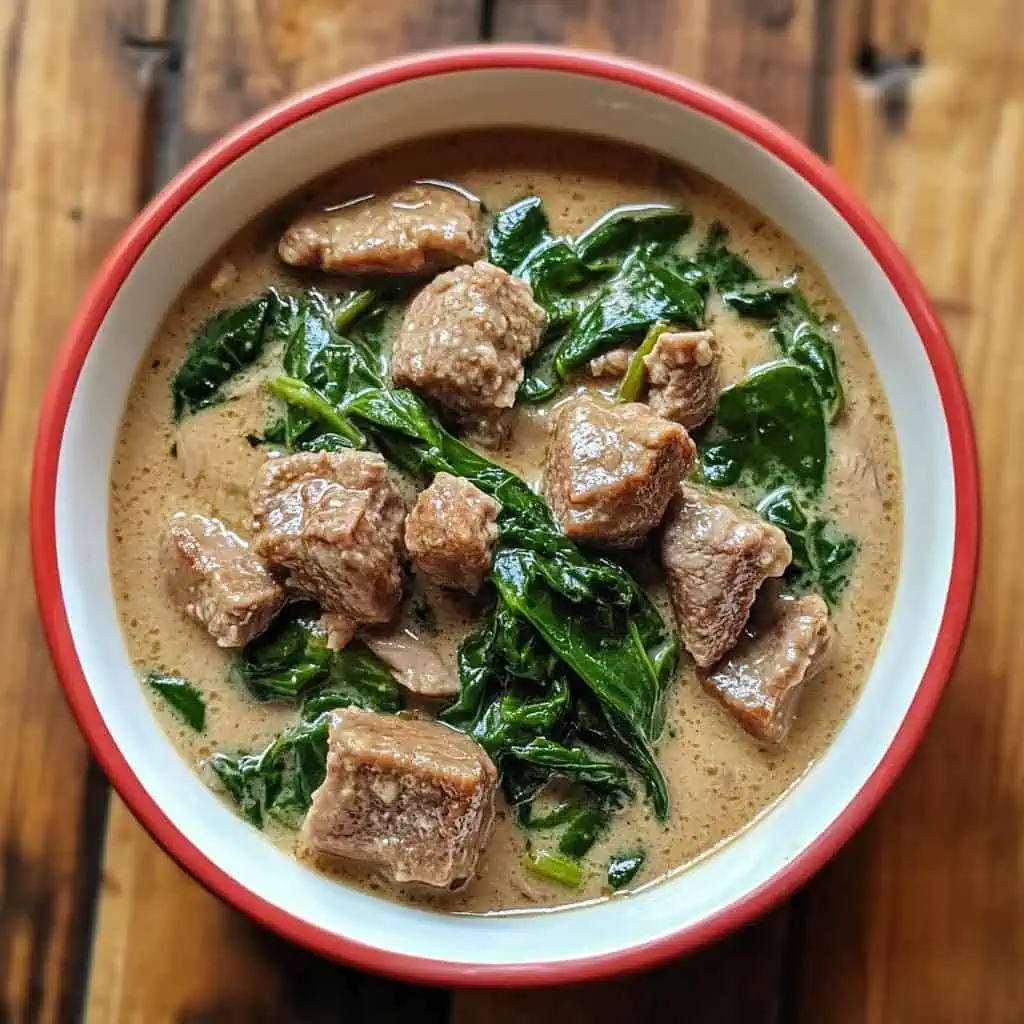I'll never forget my first bite of spinach laing during a trip to Naga City three years ago. My Tita Rose served this creamy, spicy dish that had me going back for thirds, and I knew I had to recreate it at home. The problem? Finding fresh gabi leaves in Manila was nearly impossible.
After countless kitchen experiments, I discovered that spinach works beautifully as a substitute. It's easier to find, cooks faster, and my kids actually eat their greens without complaining.
This spinach laing captures all the rich, coconut-creamy goodness of the original with that perfect balance of heat and umami that makes Bicolano food so addictive.

Why You'll Love This Recipe
This spinach laing brings all the comfort of traditional Bicolano cuisine with a nutritious upgrade! Instead of hard-to-find gabi leaves, we use readily available spinach that cooks faster and packs the same hearty flavor.
The rich coconut milk creates a creamy sauce that perfectly balances the heat from chilies and the umami depth from bagoong. It's a one-pot wonder that transforms simple ingredients into restaurant-quality Filipino comfort food your whole family will crave.
Jump to:
Ingredients
- 16 ounces fresh spinach, roughly chopped
- ½ pound pork shoulder or belly, diced into small cubes
- 1 to 1 ½ cups coconut milk
- 1 medium onion, finely minced
- 1 tablespoon fresh garlic, minced
- 1 piece fresh ginger (2-inch piece), thinly sliced
- 2-3 tablespoons bagoong (shrimp paste)
- 2 red chili peppers, finely chopped
- 2 tablespoons cooking oil

Fresh spinach wilts beautifully while maintaining nutrition, while pork adds richness and protein. Coconut milk creates the signature creamy base, and the holy trinity of onion, garlic, and ginger builds aromatic depth.
Bagoong provides that essential umami punch that makes Filipino dishes so addictive, while fresh chilies bring the heat that Bicol cuisine is famous for.
Equipment
- Large wok or deep skillet - Essential for high-heat cooking and accommodating all ingredients as they reduce
- Sharp knife - For precise dicing of pork and mincing aromatics
- Cutting board - Provides stable surface for safe ingredient prep
- Wooden spoon or spatula - Won't scratch your pan and handles high heat well
- Measuring cups - Ensures proper coconut milk ratios for perfect consistency

How To Make
- Heat your wok or large skillet over high heat and add the cooking oil, swirling to coat the bottom evenly. The oil should shimmer but not smoke.
- Add the minced garlic to the hot oil and stir constantly for about 30 seconds until fragrant, then immediately add the minced onions. Cook this mixture for 1-2 minutes, stirring frequently to prevent burning while letting the onions soften and become translucent.
- Toss in the sliced ginger and continue sautéing for another minute until the ginger releases its aromatic oils and the kitchen smells incredible.
- Add the diced pork to the wok and reduce heat to medium. Cook the pork for about 5 minutes, stirring occasionally, until the pieces are browned on all sides and starting to render their fat.
- Stir in the bagoong and chopped chilies, mixing everything together for about a minute to let the flavors meld and the shrimp paste cook slightly.
- Pour in 1 cup of the coconut milk and bring the mixture to a gentle boil, stirring to combine all ingredients into a cohesive sauce.
- Add all the chopped spinach to the wok and stir everything together. Don't worry if it looks like too much spinach - it will wilt down dramatically.
- Cover the wok and reduce heat to low, then simmer for 20 minutes, stirring occasionally to prevent sticking. The liquid should reduce significantly and the spinach should be completely wilted and tender.
- Remove from heat and taste for seasoning, adding more bagoong if needed for saltiness or more chilies for heat.
- Transfer to a serving dish and serve immediately with steamed white rice while hot.

Tips from Lola's Kitchen
- Always use fresh spinach instead of frozen - it has better texture and won't make your dish watery
- Cut your pork into uniform small pieces so they cook evenly and aren't chewy
- Don't skip browning the pork properly - this adds so much flavor to the final dish
- Add coconut milk gradually and taste as you go - some brands are saltier than others
- If your bagoong is very salty, start with less and add more to taste
- Save some fresh chilies to add at the end if you want extra heat
- Let the dish rest for 5 minutes before serving - it tastes even better slightly cooled
Substitutions
- No pork? Use chicken thighs, beef chuck, or even canned corned beef
- Vegetarian version? Skip the meat and add extra mushrooms or tofu
- No bagoong? Use fish sauce, but start with just 1 tablespoon
- Too spicy? Remove chili seeds or use bell peppers instead
- No fresh ginger? Use 1 teaspoon ground ginger powder
- Coconut milk substitute? Heavy cream works but won't have the same authentic flavor
Troubleshooting
- Too watery? Simmer uncovered longer to reduce liquid, or add a slurry of cornstarch and water
- Too salty? Add more coconut milk or a splash of water to dilute
- Not enough flavor? Add more bagoong, garlic, or ginger to taste
- Spinach too mushy? Add it later in the cooking process and don't overcook
- Pork too tough? Cut smaller or cook longer at lower heat
- Not spicy enough? Add fresh chilies at the end or serve with chili oil on the side
Storage & Reheating
- Refrigerator: Store covered for up to 3 days - flavors actually improve overnight
- Freezer: Freeze for up to 2 months in airtight containers
- Reheating: Warm gently on stovetop over low heat, adding a splash of coconut milk if needed
- Microwave: Heat in 30-second intervals, stirring between to prevent curdling
- Make ahead: Prep all ingredients the night before and cook fresh for best results

FAQ
Can I use baby spinach?
Yes, but regular spinach holds up better to long cooking
Is this dish supposed to be soupy?
No, the liquid should mostly cook down to coat the spinach
How spicy is this recipe?
Moderately spicy. Adjust chilies to your preference
Can I make this without pork?
Absolutely, it's delicious as a vegetarian dish too
What's the best coconut milk to use?
Full-fat canned coconut milk gives the richest flavor
How do I know when it's done?
The spinach should be very tender and most liquid evaporated
Can I double this recipe?
Yes, just use a larger pan and increase cooking time slightly
Related
Looking for other recipes like this? Try these:

Spinach Laing: Easy Filipino Comfort Food with a Healthy Twist
Ingredients
- 16 ounces fresh spinach roughly chopped
- ½ pound pork shoulder or belly diced into small cubes
- 1 to 1 ½ cups coconut milk
- 1 medium onion finely minced
- 1 tablespoon fresh garlic minced
- 1 piece fresh ginger 2-inch piece, thinly sliced
- 2-3 tablespoons bagoong shrimp paste
- 2 red chili peppers finely chopped
- 2 tablespoons cooking oil
Instructions
- Heat your wok or large skillet over high heat and add the cooking oil, swirling to coat the bottom evenly. The oil should shimmer but not smoke.
- Add the minced garlic to the hot oil and stir constantly for about 30 seconds until fragrant, then immediately add the minced onions. Cook this mixture for 1-2 minutes, stirring frequently to prevent burning while letting the onions soften and become translucent.
- Toss in the sliced ginger and continue sautéing for another minute until the ginger releases its aromatic oils and the kitchen smells incredible.
- Add the diced pork to the wok and reduce heat to medium. Cook the pork for about 5 minutes, stirring occasionally, until the pieces are browned on all sides and starting to render their fat.
- Stir in the bagoong and chopped chilies, mixing everything together for about a minute to let the flavors meld and the shrimp paste cook slightly.
- Pour in 1 cup of the coconut milk and bring the mixture to a gentle boil, stirring to combine all ingredients into a cohesive sauce.
- Add all the chopped spinach to the wok and stir everything together. Don't worry if it looks like too much spinach - it will wilt down dramatically.
- Cover the wok and reduce heat to low, then simmer for 20 minutes, stirring occasionally to prevent sticking. The liquid should reduce significantly and the spinach should be completely wilted and tender.
- Remove from heat and taste for seasoning, adding more bagoong if needed for saltiness or more chilies for heat.
- Transfer to a serving dish and serve immediately with steamed white rice while hot.
Tips from Lola's Kitchen
- Always use fresh spinach instead of frozen - it has better texture and won't make your dish watery
- Cut your pork into uniform small pieces so they cook evenly and aren't chewy
- Don't skip browning the pork properly - this adds so much flavor to the final dish
- Add coconut milk gradually and taste as you go - some brands are saltier than others
- If your bagoong is very salty, start with less and add more to taste
- Save some fresh chilies to add at the end if you want extra heat
- Let the dish rest for 5 minutes before serving - it tastes even better slightly cooled
The Story Behind Laing
Laing holds a special place in Filipino cuisine as one of the most beloved dishes from the Bicol region, known for its bold use of coconut milk and chilies. This traditional recipe dates back centuries and was originally created as a way to make the most of abundant gabi (taro) leaves that grew wild throughout the volcanic provinces of southern Luzon. Local families would gather these large, heart-shaped leaves and transform them into a rich, creamy dish that could feed many people with just a few simple ingredients.
The beauty of authentic laing lies in its simplicity and resourcefulness. Traditional cooks would layer dried gabi leaves with coconut milk, ginger, and whatever protein was available - often small fish, pork, or shrimp. The dish would simmer slowly over wood fires, allowing the leaves to break down and thicken the coconut milk into a velvety sauce. This cooking method not only created incredible flavor but also made the potentially irritating compounds in raw gabi leaves completely safe to eat.
What makes Bicolano laing truly special is the region's generous use of fresh coconut milk and native chilies. Unlike other Filipino dishes that might use coconut milk sparingly, laing celebrates it as the star ingredient. The coconut trees that line Bicol's coastlines provide the creamy base, while the region's love for spicy food means plenty of siling labuyo (bird's eye chilies) find their way into every pot. This combination creates the signature creamy-spicy profile that laing is famous for throughout the Philippines.










Comments
No Comments